Organic Tea Market Research, 2031
The global organic tea market size was at $905.4 million in 2021, and is projected to reach $2.4 billion by 2031, growing at a CAGR of 10.5% from 2022 to 2031.
Organic tea is a beverage that is free of synthetic substances such as chemical fertilizers, herbicides, insecticides, or fungicides. An expanding working population, rising demand for products that are ready to use, and growing retail channels are some of the factors that are anticipated to drive market expansion globally during the forecast period. The expansion of the global market is anticipated to be fueled by the growing usage of tea as a natural ingredient in the personal care sector. The expansion of the organic tea market is anticipated to be influenced by rise in disposable income levels, increase in food and beverage costs, and growth in consumer awareness of healthier lifestyles.
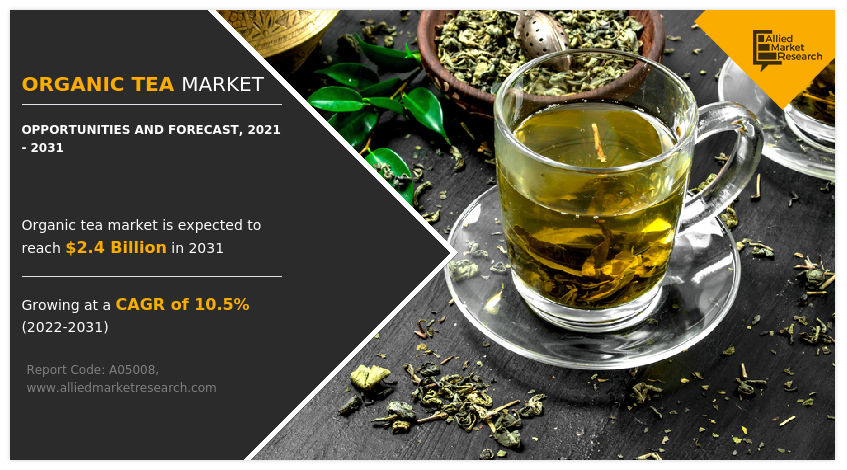
Market Dynamics
Some of the key factors that fuel market expansion include the growing consumer preference for consumables that are safe, chemical-free, and healthy. Organic tea cultivation is based on ecological cycles, biodiversity, and processes that are adapted to local conditions, which helps maintain healthy soil and fosters plant diversity. The industry is expanding as a result of steps being taken by governments in several nations to promote the use of sustainable agriculture practices through various incentives and subsidies.
The rising price of raw materials is restricting the organic tea market growth. On the other hand, the market is anticipated to grow as a result of increase in demand for herbal tea and the introduction of new organic tea flavors and varieties. Moreover, the major players in the market have implemented a marginal pricing approach, which is predicted to restrain market expansion overall. The lack of knowledge about organic teas is another factor that is anticipated to hinder the market's growth.
One of the key factors fueling market expansion is the growing consumer preference for consumables that are safe, chemical-free, and healthy. Organic tea cultivation is based on ecological cycles, biodiversity, and processes that are adapted to local conditions, which maintains healthy soil and fosters plant diversity. The industry is expanding as a result of steps being taken by governments in more nations to promote the use of sustainable agriculture practices through various incentives and subsidies.
To lessen their carbon footprint, several producers are creating tea bags with compostable and biodegradable outer packaging. In an effort to diversify their product lines and increase total sales, producers are developing ready-to-drink variations. They also spend money on cutting-edge marketing plans and celebrity endorsements, which are predicted to accelerate market growth in the coming years.
Potassium, manganese, magnesium, and niacin are just a few of the essential minerals found in coffee, an energizing beverage. It has also been shown to protect the liver, lower the risk of type 2 diabetes, and fend off a number of cancer types. Coffee is an easy replacement for tea due to its beneficial qualities. Since coffee acts similarly to tea as a refreshing beverage, it is also a substitute for tea in the eyes of consumers. A rise in the trend of coffee use outside the home and a number of surveys conducted among people by recognized organizations indicate an increase in coffee consumption in recent years. Altogether, the aforementioned arguments show how growing coffee consumption can be detrimental to the organic tea market.
Businesses currently engaged in the organic tea sector are launching various types of organic blended leaves products, organic green tea, organic fruit tea, and more in an effort to expand their product lines and boost market sales. There are many other enticing flavors as well, such as organic tiramisu black tea, caramel truffle herbal tea, custard tart herbal tea, apple pie à la mode herbal tea, peach turmeric herbal tea, caramel apple tea, and others. There is growing organic tea market demand among consumers due to their superior quality and delicious flavor. These factors will probably persuade different competitors to launch unique organic tea flavors in an effort to boost sales, opening up a lot of opportunities for the market during the market forecast.
The organic tea market is growing due to its easy accessibility, leading to a greater penetration of the product around the world. Industry participants have also increased their efforts in developing distinctive products in the black, white, green, and oolong tea categories to meet the diverse preferences and health needs of customers.
The increase in global acceptance of portable and instant foods and drinks is responsible for the surge in tea bag sales. Tea bags also have a considerable market share due to its straightforward preparation process. The growing popularity of ready-to-drink beverages and good hydration has greatly assisted the growth of the tea bag business. Tea bags come in a number of flavors, allowing consumers to carry a selection of teas with them and consume them on-the-go. Consumers nowadays are looking for distinctive flavors in a variety of organic teas. Producers of organic tea have benefited from the contemporary trend of secure packaging by utilizing more food-grade tea bags, an innovative packaging design that guarantees the security of stored food. In the not-too-distant future, this is anticipated to fuel the segment's expansion.
Organic tea is widely used as a nutritious food and is especially beneficial for those with obesity, heart disease, and high cholesterol. One of the main factors driving the growth of organic teas is the rising customer desire for healthy food and beverage items. Organic tea is well-known for lowering excessive body fat and boosting metabolism without having any unfavorable side effects. The tea retains its distinctive properties and medicinally significant components due to its organic production. This makes it a healthier tea in comparison to other products.
Segmental Overview
The global organic tea market is analyzed on the basis of type, packaging, distribution channel, and region. On the basis of type, the market is divided into green tea, black tea, oolong tea, and others. On the basis of packaging, the market is divided into plastic containers, aluminum tins, paper boards, and others. On the basis of distribution channel, it is classified into supermarkets/hypermarkets, convenience stores, and online stores. On the basis of region, the market is analyzed across North America, Europe, Asia-Pacific, and LAMEA.
By Type
The green tea product type dominated the global market in 2021 and is anticipated to maintain its dominance throughout the organic tea market forecast period. Green tea is in high demand worldwide due to its qualities, including the health advantages it offers users. Consistent consumption of green tea reduces body fat. The global market is experiencing growth due to factors like rise in consumer awareness of the need for healthy and safe products, an increase in the number of people suffering from diseases like obesity, cancer, digestive disorders, and others, as well as benefits from regular green tea consumption.
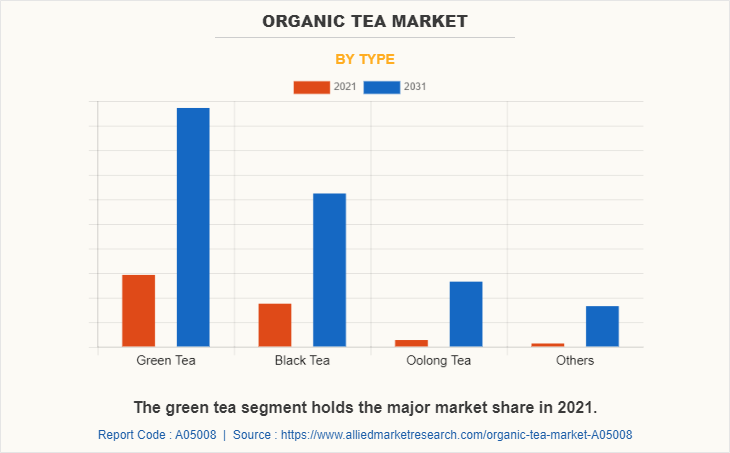
By Packaging
The plastic containers segment dominates the global organic tea market. Convenience drives the plastic containers segment. Perishables can be stored for a long time in plastic containers, which are lightweight and portable. Moreover, plastic containers have the ability to be filled again, making them a very practical and feasible solution for the storage of a variety of food and beverage products, including different types of tea.
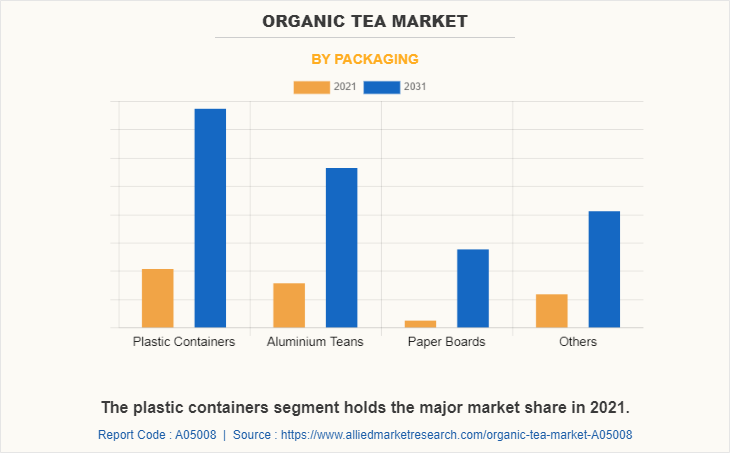
By Distibution Channel
The supermarkets/hypermarkets segment exhibits the fastest growth in the global organic tea market. The expansion of supermarkets and hypermarkets in both developed and developing economies is responsible for the growth of the supermarkets/hypermarkets segment in the market.
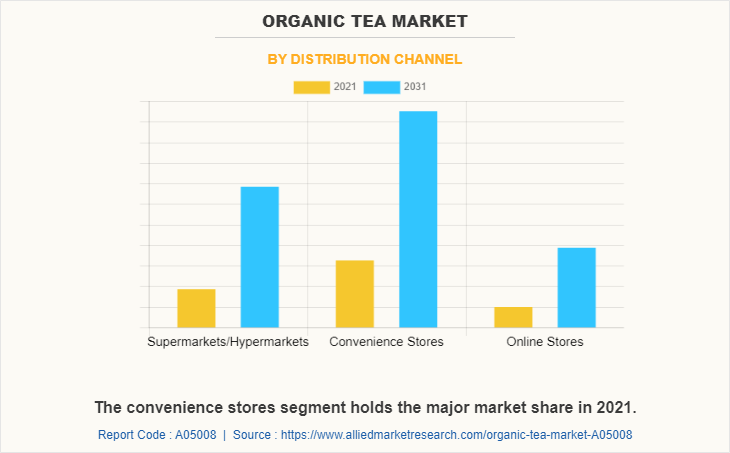
By Region
On the basis of region, Asia-Pacific dominated the market with the largest share during the forecast period. The Asia-Pacific region is driving the organic tea market since tea use has been documented in the region's history and is still a part of breakfast and midday meals now. Along with being the largest consumer of tea, Asia-Pacific is regarded as the region that produces the most tea.
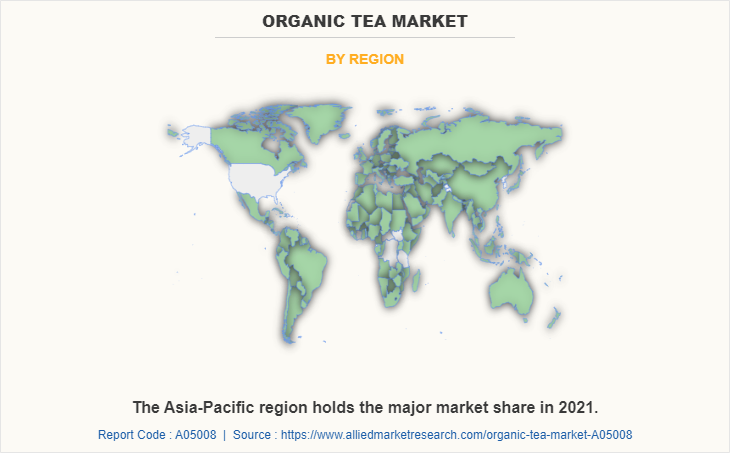
Competitive Landscape
The major players analyzed for the organic tea industry are Tata Consumer Products, Unilever, Associated British Foods PLC, Vadham Teas Private Ltd., Celestial Seasonings, Bombay Burmah Trading Corp. Ltd., Stash Tea Company, R.C. Bigelow, Inc., Barrys Tea, Hain Celestial Group, Inc., ITO EN, Ltd., Numi, Inc., Organic Tea, Hlssen & Lyon GmbH, Tazo Tea Company, Newman's Own, Inc., PepsiCo, The Coca-Cola Company, Shangri-La Tea Company, Inc., and Yogi Tea GmbH. Key players operating in the market have adopted product launch, business expansion, and mergers & acquisitions as key strategies to expand their organic tea market share, increase profitability, and remain competitive in the market.
Key Benefits for Stakeholders
- This report provides a quantitative analysis of the market segments, current trends, estimations, and dynamics of the organic tea market analysis from 2021 to 2031 to identify the prevailing organic tea market opportunities.
- The market research is offered along with information related to key drivers, restraints, and opportunities.
- Porter's five forces analysis highlights the potency of buyers and suppliers to enable stakeholders make profit-oriented business decisions and strengthen their supplier-buyer network.
- In-depth analysis of the organic tea market segmentation assists to determine the prevailing market opportunities.
- Major countries in each region are mapped according to their revenue contribution to the global market.
- Market player positioning facilitates benchmarking and provides a clear understanding of the present position of the market players.
- The report includes the analysis of the regional as well as global organic tea market trends, key players, market segments, application areas, and market growth strategies.
Organic Tea Market Report Highlights
| Aspects | Details |
| Market Size By 2031 | USD 2.4 billion |
| Growth Rate | CAGR of 10.5% |
| Forecast period | 2021 - 2031 |
| Report Pages | 290 |
| By Type |
|
| By Packaging |
|
| By Distribution Channel |
|
| By Region |
|
| Key Market Players | Tata Consumer Products Limited, Associated British Foods PLC, Vahdam Teas Private Limited, PepsiCo, Unilever PLC, The Bombay Burmah Trading Corporation, Limited, Tazo Tea Company, YOGI TEA GmbH, Shangri-La Tea Company, Inc., NUMI, INC., Stash Tea Company, Hlssen & Lyon GmbH, The Hain Celestial Group, Inc., ITO EN, LTD., The Coca-Cola Company, Newman's Own, Inc., Barrys Tea, R.C. Bigelow, Inc., Organic India Pvt. Ltd., HAIN CELESTIAL GROUP, INC. |
Analyst Review
The perspectives of the leading CXOs in the organic tea industry are presented in this section. The CXOs claim that tea producers have been able to launch high-end, health-focused products due to consumers' rising disposable incomes. In order to combat some of the most prevalent health concerns, many tea brands have begun incorporating a number of healthful components into the formulations of their organic tea.
According to CXOs, factors that support market expansion include the market for organic tea is impacted by three significant determinants such as health, fitness, and habit. Since green tea contains a variety of minerals and has several health advantages, consumers' interest is turning towards this beverage. Several vitamins, amino acids, flavonoids, and trace minerals found in organic tea contribute to a stronger immune system, enhanced metabolism, lower cholesterol, cancer prevention, and other health advantages. As a result, there have been new introductions of unique organic tea products such as herbal and fruit tea, various kinds of green tea, and blends of black and green leaves. The aforementioned factors suggest that the above organic tea products will have significant growth potential during the forecast period.
The global organic tea market size was valued at $905.4 million in 2021, and is projected to reach $2,421.2 million by 2031, registering a CAGR of 10.5% from 2022 to 2031.
The forecast period in the organic tea market report is 2022 to 2031.
The base year calculated in the organic tea market report is 2021.
The green tea segment is the most influential segment in the organic tea market report.
The top companies analyzed for global organic tea market report are Tata Consumer Products, Unilever, Associated British Foods PLC, Vadham Teas Private Ltd., Celestial Seasonings, Bombay Burmah Trading Corp. Ltd., Stash Tea Company, R.C. Bigelow, Inc., Barrys Tea, Hain Celestial Group, Inc., ITO EN, Ltd., Numi, Inc., Organic Tea, Hlssen & Lyon GmbH, Tazo Tea Company, Newman's Own, Inc., PepsiCo, The Coca-Cola Company, Shangri-La Tea Company, Inc., and Yogi Tea GmbH.
Asia-Pacific holds the maximum market share of the organic tea market.
Loading Table Of Content...
Loading Research Methodology...


